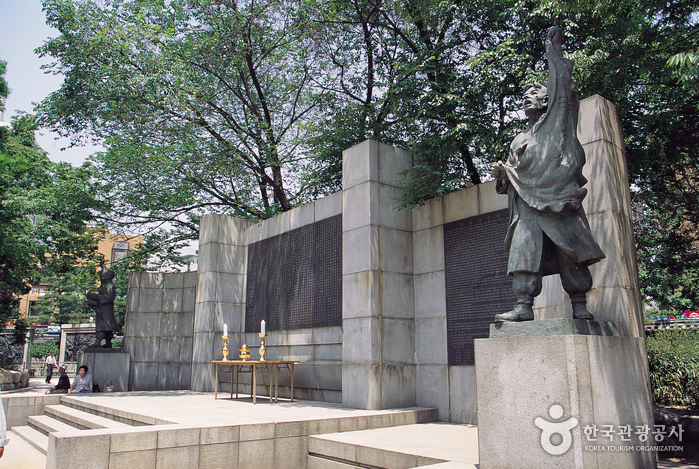Tapgol Park, designated as a Historic Site, was the first modern park built in Seoul. The park is located at the original site of Wongaksa Temple, constructed during the 13th year of Joseon King Sejo’s reign. However, the temple was destroyed, and the site did not become a park until 1897, following a proposal by Englishman John McLeavy Brown, an advisor to King Gojong. The park is also significant for being the starting point of the March 1 Independence Movement in Seoul. Originally named Pagoda Park, it was changed to the current Tapgol Park on May 28, 1992. The park contains several monuments and heritage sites, including the Ten-story Stone Pagoda of Wongaksa Temple Site (National Treasure), the Stele for the Construction of Daewongaksa Temple at Wongaksa Temple Site (Treasure), Palgakjeong Pavilion (where the Independence Proclamation was first declared), the independence movement relief plate, and the statue of Son Byeong-hee.
Tapgol Park, formerly known as Pagoda Park, is a small (19,599 m2 [4.843 acres]) public park located at 99 Jong-ro (street), Jongno-gu, Seoul, South Korea. This park was once the site of Wongaksa (Buddhist Temple). The word “tap” means “pagoda,” and the park derives its name from the Wongaksa Pagoda, a 10-storied stone pagoda (National Treasure No.2) located in the park.
It was previously the site of a 15th-century Buddhist temple, and remnants such as a 10-storied stone pagoda and a few relics of the temple can still be seen in the park. The park was organized as a garden and national park by John McLeavy Brown, the Irish advisor to a provincial subdivision, in 1897.
One of the monuments in the park is the Monument of Wongaksa, built in 1471 to record the founding of Wongaksa (temple) in 1465. On the front is an inscription composed by Kim Suon, with calligraphy done by Seong Im. On the back, there is an inscription composed by Seo Geo Jeong, with calligraphy done by Jeong Nam Jong. The turtle-shaped base is constructed from granite, and the body is cut from marble. The monument measures 1.3 meters/4.3 feet wide and stands 4.9 meters/16.2 feet in height. Two elaborately carved intertwined dragons rising toward the sky, holding a Buddhist gem, reside on the top of the monument. The Monument of Wongaksa is designated as Treasure #2.
Tapgol Park is historically important as the site of the origin of the March 1st Movement in 1919, a crucial part of the Korean independence movement and the first location for the reading of the Proclamation of Independence. The park features a number of bas-relief statues representing Korean patriots, the Proclamation of Independence Monument, and a poem by Han Yong-un.
As an important place in modern Korean history, it is a popular venue for various types of demonstrations. It was the designated termination point of the Grand Peace March for Democracy on June 24, 1986, which led to the acceptance of free elections by President Chun Doo-hwan of South Korea. The park is served by Jongno 3-ga Station on Lines 1, 3, and 5 of the Seoul Subway.
More informations
- Address99, Jong-ro, Jongno-gu, Seoul
서울특별시 종로구 종로 99
Gallery




